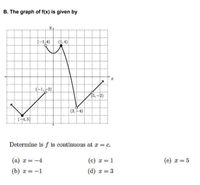
Calculus: Early Transcendentals
8th Edition
ISBN: 9781285741550
Author: James Stewart
Publisher: Cengage Learning
expand_more
expand_more
format_list_bulleted
Question

Transcribed Image Text:B. The graph of f(x) is given by
(-14)
(1,4)
(-1,–2)
(5,-2)
(3, -4)
(4, 5)
Determine is f is continuous at x = c.
(a) x = -4
(c) x = 1
(e) x = 5
(b) x = -1
(d) z 3
Expert Solution
This question has been solved!
Explore an expertly crafted, step-by-step solution for a thorough understanding of key concepts.
This is a popular solution
Trending nowThis is a popular solution!
Step by stepSolved in 2 steps with 2 images

Knowledge Booster
Similar questions
- 4. Over what interval is the function shown in the f(x) = 3x2 (x, y) table decreasing? -2 12 (-2, 12) -1 3 (–1, 3) (0,0) The table is decreasing over the interval 1 3 (1, 3) 12 (2, 12) 2.arrow_forwardif i have the function how would i make a sign chartarrow_forward10) Find (¹)(3) if f(x)=x²+x-1.arrow_forward
- Consider the graph of the function f given below. f(x) -2 -4 B) If h(x) = 2 0 2 X 4 A) If g(x) = xƒ(x), calculate g' (3). [Select] x² ƒ(x)' C) If i(x) = x² ƒ(x), calculate ¿" (−1). [Select] calculate h' (−1). [Select]arrow_forward20. If f"(x) = (x – 2)(x + 3)F (x – 5)*, then the graph of f has inflection points where x = (A) -3 and 2 only (B) –3 and 5 only (C) 2 and 5 only (D)-3, 2, and 5arrow_forwardlet f(x)={x^2+2, x >-1 AND -x^2-x, x less than for equal to -1} compute f(0), f(-1)and f(-2) a. 0, 2, 6 b. 2, 0, 6 c. 2, 2, 6 d. 2, 0, -2 e. 0, 1, -2arrow_forward
- 14. Given the following graph of the function y= f(x), construct the graph of the function y= f"(x). (0,2), (1,3), (2,5), (3,9), (-1,1.5) -8 7- -5 -3 -9 -8 -7 -6 -5 -4 -3 -2 2 6 -2 Solution: https://youtu.be/plmnlQ2nb3g PRESSarrow_forwardEx. 5) For R and Q functions and given that: Q(-1) = 5, R(-1) = -4, R(5) = 7; || Q'(-1) =-3, R'(-1) =2, R'(5) =-1 If f(x) = R(Q(x)), then evaluate f"(-1). f"(-1)=arrow_forward
arrow_back_ios
arrow_forward_ios
Recommended textbooks for you
 Calculus: Early TranscendentalsCalculusISBN:9781285741550Author:James StewartPublisher:Cengage Learning
Calculus: Early TranscendentalsCalculusISBN:9781285741550Author:James StewartPublisher:Cengage Learning Thomas' Calculus (14th Edition)CalculusISBN:9780134438986Author:Joel R. Hass, Christopher E. Heil, Maurice D. WeirPublisher:PEARSON
Thomas' Calculus (14th Edition)CalculusISBN:9780134438986Author:Joel R. Hass, Christopher E. Heil, Maurice D. WeirPublisher:PEARSON Calculus: Early Transcendentals (3rd Edition)CalculusISBN:9780134763644Author:William L. Briggs, Lyle Cochran, Bernard Gillett, Eric SchulzPublisher:PEARSON
Calculus: Early Transcendentals (3rd Edition)CalculusISBN:9780134763644Author:William L. Briggs, Lyle Cochran, Bernard Gillett, Eric SchulzPublisher:PEARSON Calculus: Early TranscendentalsCalculusISBN:9781319050740Author:Jon Rogawski, Colin Adams, Robert FranzosaPublisher:W. H. Freeman
Calculus: Early TranscendentalsCalculusISBN:9781319050740Author:Jon Rogawski, Colin Adams, Robert FranzosaPublisher:W. H. Freeman
 Calculus: Early Transcendental FunctionsCalculusISBN:9781337552516Author:Ron Larson, Bruce H. EdwardsPublisher:Cengage Learning
Calculus: Early Transcendental FunctionsCalculusISBN:9781337552516Author:Ron Larson, Bruce H. EdwardsPublisher:Cengage Learning

Calculus: Early Transcendentals
Calculus
ISBN:9781285741550
Author:James Stewart
Publisher:Cengage Learning

Thomas' Calculus (14th Edition)
Calculus
ISBN:9780134438986
Author:Joel R. Hass, Christopher E. Heil, Maurice D. Weir
Publisher:PEARSON

Calculus: Early Transcendentals (3rd Edition)
Calculus
ISBN:9780134763644
Author:William L. Briggs, Lyle Cochran, Bernard Gillett, Eric Schulz
Publisher:PEARSON

Calculus: Early Transcendentals
Calculus
ISBN:9781319050740
Author:Jon Rogawski, Colin Adams, Robert Franzosa
Publisher:W. H. Freeman


Calculus: Early Transcendental Functions
Calculus
ISBN:9781337552516
Author:Ron Larson, Bruce H. Edwards
Publisher:Cengage Learning